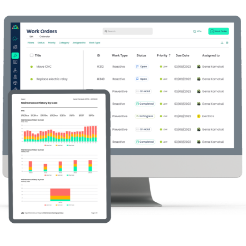
How CMMS Bridges Maintenance and Production Processes to Improve Asset Performance
Too often, production and maintenance departments operate in silos, resulting in a lack of communication and collaboration between departments, particularly between maintenance and production. As a result, each department operates independently, with limited visibility into the other's priorities, data, or workflows. Since production is driven by output, deadlines, and throughput targets, and maintenance teams’ focus is on reliability, safety, and minimizing equipment failure, this divide often leads to inefficiencies, misaligned goals, and missed opportunities for optimizing asset performance. The consequences for organizations that operate in silos are costly downtime, reactive fixes, and a lack of shared visibility into equipment health.
A Computerized Maintenance Management System (CMMS) bridges this gap by serving as a unified digital platform that connects both functions, allowing each to see and understand the other. Rather than treating maintenance as an afterthought or emergency response, CMMS software enables maintenance tasks to be proactively planned, scheduled, and executed in alignment with production demands. This coordination reduces conflicts over equipment access, ensures that critical maintenance isn’t skipped during high-demand periods, and ultimately improves overall equipment effectiveness (OEE). According to Cryotos, when maintenance and production teams collaborate through a centralized CMMS, they can significantly enhance asset lifecycle management, reduce mean time to repair (MTTR), and streamline communication across departments.

Because industries are experiencing growing pressure to do more with less, CMMS adoption is emerging as a key strategy for integrating frontline operations. In this article, we’ll explore how CMMS tools help synchronize production and maintenance workflows, why this matters for asset performance, and what organizations can do to maximize the value of their CMMS investment.
CMMS – A Unifying Digital Platform
A CMMS serves as a centralized data hub, collecting, organizing, and sharing critical asset and maintenance data across both maintenance and production teams. Utilizing real-time information on work orders, asset history, condition monitoring, and preventive maintenance schedules, the system ensures that maintenance teams have access to a single source of data. This transparency reduces miscommunication, eliminates redundant efforts, and helps both departments align their daily activities with broader operational goals.
One of the most powerful features of a CMMS is its scheduling and work order management capabilities. Maintenance tasks can be planned around production schedules, minimizing disruptions to output while ensuring necessary and ongoing upkeep. When integrated with production calendars, CMMS platforms can help maintenance managers to anticipate busy periods, schedule downtime strategically, and prioritize tasks based on equipment criticality and usage patterns.
Additionally, real-time alerts and mobile access empower technicians and operators to respond quickly to issues as they arise. Whether it’s a sudden equipment fault detected by a sensor or a manually logged concern from the production floor, the CMMS enables fast, documented communication. This capability not only shortens response times but also fosters a culture of shared responsibility for asset health. In this way, production and maintenance teams collaborate rather than working at cross purposes.
CMMS-Powered Collaboration in Action
A CMMS promotes cross-departmental collaboration by enabling real-time visibility into asset status, usage trends, and maintenance history. Access to shared dashboards and centralized records allows production and maintenance teams to monitor equipment performance and anticipate potential issues. Joint visibility encourages proactive decision-making, such as adjusting production plans to accommodate scheduled maintenance or flagging assets that are underperforming due to wear or misalignment.
Preventive maintenance also becomes more effective when informed by production data. Instead of relying solely on time-based intervals, CMMS platforms offer the option to schedule maintenance based on usage metrics such as run hours, cycle counts, or output volume. This approach ensures equipment is serviced only when needed, maximizing uptime while avoiding unnecessary interventions. It also helps production teams maintain a predictable workflow, as maintenance becomes less of a surprise disruption and more of a planned collaboration.
Finally, CMMS analytics empower teams to perform root cause analyses by linking breakdowns or inefficiencies to specific operating conditions or maintenance gaps. When both departments contribute data—such as when a machine fails during a particular shift or after a specific process—performance patterns can be identified. The shared goal of achieving optimal asset performance guides this valuable insight.

Benefits for Asset Performance & Production
When maintenance and production teams collaborate by using a CMMS, the most immediate and measurable benefit is a reduction in unplanned downtime. By coordinating maintenance schedules with production needs and using real-time data to anticipate failures, organizations can prevent costly disruptions and extend the lifespan of critical equipment. These advantages directly contribute to improved overall equipment effectiveness (OEE), as all three key metrics—availability, performance, and quality—benefit from a more synchronized approach to asset maintenance. In turn, maintenance becomes less reactive and more strategic, lowering emergency repair costs and reducing the strain on technicians and operators alike.
Beyond efficiency gains, CMMS-driven integration creates a safer and more compliant working environment. With maintenance tasks properly documented, inspections completed on schedule, and potential hazards flagged in real-time, teams can ensure that regulatory requirements are met and minimize workplace risks. Additionally, improved asset reliability aids consistent production output, enabling organizations to meet customer demand without last-minute delays or quality issues. The result is a streamlined operation where both departments are aligned, empowered, and jointly responsible for asset performance.
Building CMMS-Driven Collaboration
Establishing strong collaboration between maintenance and production involves more than just implementing a CMMS—it consists of aligning goals, metrics, and workflows to ensure seamless integration. One effective way to facilitate this alignment is by defining and tracking shared KPIs such as mean time to repair (MTTR), mean time between failures (MTBF), and overall equipment effectiveness (OEE). When production and maintenance departments are evaluated based on the collective performance of their assets, rather than isolated departmental targets, it encourages a more unified and cooperative mindset. This alignment helps shift the culture from “us vs. them” to a more holistic approach focused on mutual success.
To further strengthen this cross-functional partnership, organizations should consider conducting joint CMMS training and implementing user adoption strategies to enhance the effectiveness of the partnership. When production operators understand how to log issues, check maintenance status, and interpret basic asset data, they become active participants in equipment reliability. Likewise, integrating the CMMS with other operational systems, such as enterprise resource planning (ERP) or manufacturing execution systems (MES), creates a smooth flow of information across departments. This interconnectedness enables faster decision-making, reduces duplication, and cultivates a culture of shared accountability for asset performance.
Pitfalls to Avoid
While a CMMS can significantly improve coordination between maintenance and production, its effectiveness depends on how well it is implemented and adopted. One common pitfall is treating the system as a maintenance-only tool. When production teams aren’t involved in data entry, reporting, or decision-making, there is a risk that the CMMS may become just another silo rather than a bridge. Ensuring both departments contribute to and utilize the system is critical to realizing its full value. To achieve this end, the process involves clearly defining roles, encouraging shared ownership, and emphasizing the importance of consistent and accurate data input from all users.
Another challenge facing organizations is underestimating the cultural shift required to break down longstanding departmental barriers. Simply adopting new technology won’t remove deeply ingrained habits, beliefs, or rivalries. To address these issues, leadership must actively promote cross-functional collaboration and provide training that emphasizes the joint benefits of using the CMMS. Finally, failing to track and act on performance metrics can impede progress and negate the benefits that a CMMS offers. Without dashboards that visualize key trends and outcomes, teams miss opportunities to learn, adjust, and continuously improve. Avoiding these pitfalls ensures that CMMS implementation is not just a technical upgrade but a strategic transformation of an organization’s maintenance operations.
Conclusion
As organizations continue to address mounting pressure to maximize efficiency, reduce downtime, and protect valuable assets, the need for alignment between production and maintenance has never been more urgent. A CMMS provides the digital foundation to bridge these historically siloed functions, enabling maintenance managers to establish real-time communication, shared accountability, and data-driven decision-making. By uniting production and maintenance departments through CMMS’s centralized platform, businesses can significantly enhance asset performance, increase overall equipment effectiveness, and foster a more agile and collaborative operating environment.
To initiate this transformation, organizations should first assess how effectively their current systems support cross-functional workflows. Some questions to be considered include: Are maintenance schedules coordinated with production cycles? Do both teams have access to shared data? Is the CMMS being used as a strategic tool or simply a digital filing cabinet? Taking steps to integrate production and maintenance efforts through your CMMS can unlock untapped performance gains and prepare your operation for the demands of modern industry.
TABLE OF CONTENTS
Keep Reading
Tax season is the time of year that often sends a ripple of anxiety through many of us. The ...
11 Nov 2025
Selecting a Computerized Maintenance Management System (CMMS) can, at first glance, be an ...
4 Nov 2025
In healthcare facilities, equipment uptime involves more than achieving operational ...
31 Oct 2025
Companies are subject to economic ups and downs, also known as economic volatility. Today, ...
30 Oct 2025
Maintenance challenges are a constant struggle, with unplanned downtime costing manufacturers ...
27 Oct 2025
Last winter, a maintenance technician at a U.S. paper mill ignored a predictive alert that ...
10 Oct 2025
Many organizations proudly say they “have a CMMS,” but ownership alone doesn’t equal ...
9 Oct 2025
Every maintenance team is under pressure to do more with less. Unplanned downtime is often ...
7 Oct 2025
The implementation of simple, yet powerfully effective, checklists has repeatedly ...
3 Oct 2025
In manufacturing, every second counts. When production stops, whether due to scheduled ...
2 Oct 2025
The increasing cost of maintenance, lack of accountability, and siloed systems leave many ...
30 Sep 2025
Preventive maintenance is one of those things maintenance teams know they need to do, but it ...
26 Sep 2025
Public services are essential to daily life. The provision of safe roads, functional transit, ...
25 Sep 2025
For most manufacturing facilities, a major focus of their maintenance teams revolves around ...
24 Sep 2025
Have you ever tried explaining to the CEO why the production line has been down for hours ...
18 Sep 2025
Over the past few decades, the hotel industry has undergone a dramatic transformation. ...
16 Sep 2025
Profitability is at the top of the list for manufacturing organizations when conversations ...
12 Sep 2025
Lean manufacturing is a goal that organizations strive for in their quest for operational ...
11 Sep 2025
In many organizations, the primary focus of maintenance work is on completing work orders, ...
9 Sep 2025
Word order backlogs are a reality that all maintenance and facilities management teams face. ...
5 Sep 2025





